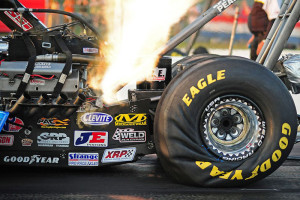Acceleration in my world of racing has two major components: power and traction. Using this metaphor, how can we accelerate to get what we want in our world?
Understanding acceleration in driving
In a rally car, the engine generates power. Sometimes getting those last few horses out of an engine can mean engineering it near its physical and mechanical limits. Drag racers, for example, are notorious for building engines that literally explode after about six seconds. They are designed specifically to give the user maximum horsepower for the duration of his or her task. The engine disintegrates, but there are lots of mechanics, parts, and money back in the pits to rebuild for the next run.
Track race cars use engines designed to give maximum power in a limited range of revolutions per minute (rpm). We call them “peak-y,” meaning that, above or below that peak in rpm, the engine does not produce maximum horsepower.
In rally cars, we can’t push our engines to that limit. We want power and torque over a broad rpm range so that we can use our engine to accelerate out of danger.
Your daily driver has an engine with mild horsepower and a very broad power band (range of rpm) so that you can drive sanely and safely under a wide variety of conditions. You will notice that your car can “lug” along at low rpm until your automatic transmission downshifts and brings the engine up to a more efficient rpm range. If you have a manual transmission (yes, they still sell them), you can lug along at a low rpm with little power.
Just because we have power doesn’t mean we automatically win. Whether we’re drag racing, track racing, or rallying, we still have to get all those ponies to the ground so that we can accelerate. The component that does that is commonly called traction.
How we deal with traction is how we deal with the friction between our tires and the surface they ride on.
In drag cars you will see huge tires with no tread and very little air pressure. This maximizes the surface-to-surface contact so that all that power the engine produces (for six seconds) is transferred to the ground and the car can accelerate blindingly fast. Acceleration is violent, exciting to watch, and costly.
On a racetrack, teams choose from various tires as they gamble on which formula will give them the best traction for the power they are developing. There is no end to the types of rubber compounds and treads.
On rally cars, the determining factor for traction is our road surface. We can be racing on pavement, sticky dirt, gravel, ice, snow, deep mud. And sometimes these occur on the same racing stage!
Our choices are even more numerous than track racing. There are gravel tires and soft, medium, and hard tires. We bring tire groovers to modify the tread to accommodate the conditions experienced from hour to hour. There are tarmac tires for pavement, snow tires for crunchable snow, ice tires for the slippy stuff (and we will frequently “tractionize” these, cutting up the tread thousands of times to make the tire look like a round chia pet). We do whatever we have to do to minimize slipping. Picture our tires always clawing for grip.
Applying power and traction to your life
So you want to accelerate. You’ve got a plan, an idea, a dream. You’ve set mental and emotional resources aside to go get your (insert dream here). You have energy. You’ve shared the vision with your friends and family. Full steam ahead. Katie, bar the door. You’ve got plenty of horsepower.
How do you manage that horsepower? Are you a drag car? Peak-y? Prone to blowing up (burnout)? Are you a race car…less peak-y than a drag car, but still requiring skill to keep the engine right in the power band? Are you a rally car? Broader power, easier to recover? Developed for longevity? Perhaps you’re a daily driver? Relatively low horsepower and hard to make a mistake with, but also hard to accelerate meaningfully?
I like to keep myself somewhere between rally and race mode. I want good power, and I want to develop the skills to keep my project in the power band so that my acceleration can be maximized. If I move too far toward drag car, I burn out. I’ve experienced that. Working 24/7 on a project I know I can make happen—it’s wearing on a soul. Mostly my engine doesn’t last long enough in this mode. And backing down to daily driver, well, the world passes me by as I cruise a few miles per hour under the speed limit.
But what about traction? What does traction have to do with getting what I want?
Too much power and not enough traction leaves me spinning my wheels, literally going nowhere. But too much stick to the ground without the horsepower to drive it kills the engine. You’ve killed the engine, haven’t you? You recognize that.
Traction, as I see it, is how I manage the resources (style, compound, tread, treatment) required to accelerate.
Traction for my dreams and aspirations usually requires other people. These projects usually need co-conspirators, investors, cheerleaders. They do not need detractors, naysayers, and doomsday divas.
Traction may require commandeering other resources, like altering how I view my finances and personal resources (letting go of things I like to do).
It may require that I let go of some things I take as reality (my personal truth, which I sometimes refer to as head trash!).
In short, traction can be improved by simply spending more time in my Learner/Researcher mode than in my Knower/Judger mode. There are things I will need to know in order to accelerate. I have to be open to seeing things differently than I’ve seen them in the past. I can’t simply force a gravel tire to have traction on ice. I can’t do what I’ve always done to get something different.
Kim’s formula for achieving goals
I want good broad-spectrum horsepower—energy, enthusiasm, and grit. I want it to work over a large band of situations so that I can always grab a lower gear and continue to accelerate.
+
I want to corral resources. I want to make good use of people, manage my own prejudices, and gather new information so that this horsepower is not wasted on spinning tires.
With this kind of power and traction, acceleration is in my control. I can get what I want more quickly and with a stronger sense of being in the driver’s seat.
Race teams monitor their engines with gauges and digital codes continuously. They look at the condition of their tires at every opportunity, prepared to adjust. Race teams win because they are present, in the mode of the L/R. They are prepared to adjust to maximize acceleration.
Am I? Are you?



